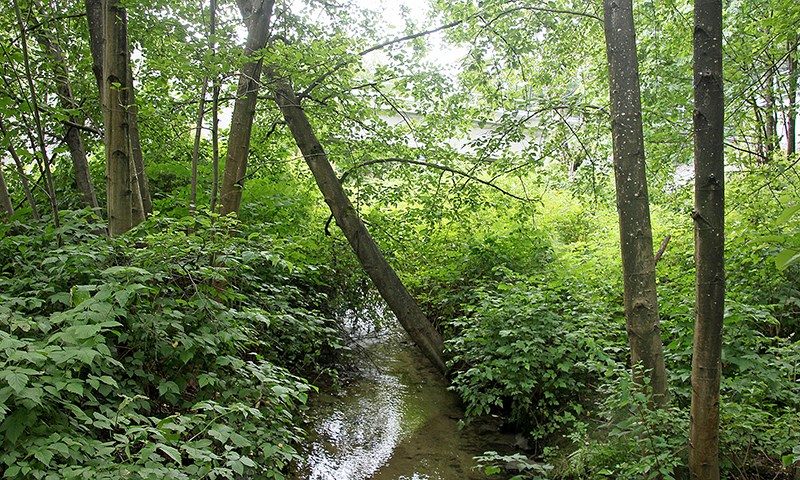South Schoolhouse Creek in Port Moody has its headwaters in the Chines escarpment along Port Moody’s southern border with Coquitlam.
This stream flows from Miller Park in Coquitlam down through the steeply incised Miller ravine, where it emerges just behind Port Moody secondary school. Beyond the school, the creek runs a gauntlet of six culverts to cross Albert, St. Johns and Clarke streets, then under parts of the Reichhold chemical plant, followed by the last and very long culvert under the railway tracks before finally discharging into Burrard Inlet on the Pacific Coast Terminals property.
Without a doubt, some of the best salmon habitat in the lower reaches of this creek was long ago converted into culverts and fish ladders. Despite having some potentially outstanding salmon habitat through a forested ravine in the College Park/Easthill area, an impassable perched culvert under Barnet Highway sadly prevents any salmon access into the upper reaches of Melrose Creek.
As is the case with so many urban streams, development has not been kind to South Schoolhouse Creek. Landslides in Miller Ravine, probably related to development too close to its steep and unstable slopes, have periodically discharged soil and debris into the creek. Development has also nibbled away at the riparian forested zones, which are so essential to create the shade that cools streams and produces the insects upon which salmon depend. For example, when Barnet Highway was widened about two decades ago, the creek lost most of its western riparian edge in the vicinity of Clarke Street.
Over a third of the lower reaches, typically the most productive portions, of South Schoolhouse Creek have been culverted.
Despite these drawbacks, salmon keep returning to South Schoolhouse. Volunteers from both Mossom and Noons Creek hatcheries have periodically released juvenile coho and chum into the creek while resourceful coastal cutthroat have found it on their own. Chum tend to be the main spawners in South Schoolhouse. These fish, which move to salt water soon after young alevin emerge from the gravel each spring, have the advantage of only requiring fresh water for the first few weeks of their life and for spawning at the end of it.
Recent years have presented new challenges to the fish in South Schoolhouse. During construction of the Evergreen Line tunnel in 2013, a spill of grout into the creek elevated its pH level for a short time and killed 180 fish, most of them sculpin. Studies conducted in 2014 by the Evergreen Skytrain project team determined the creek had mostly recovered from this impact, with both coastal cutthroat and coho salmon found in the area impacted by the grout.
Last winter during a windstorm, a tree fell and broke a sewage pipe that crossed over Melrose Creek in the College Park area; this resulted in the release of large amounts on raw sewage into the creek that would have killed most of fish downstream. Thankfully, any fish in the lower reaches of Schoolhouse would have been spared the impacts of raw sewage as long as they remained above its confluence with Melrose Creek.
To their credit, the people in charge of the Evergreen SkyTrain project have decided to undertake a massive rehabilitation of South Schoolhouse Creek. This work will involve the removal of invasive plants such as knotweed and Himalayan blackberry, followed by replanting of the riparian zone with more appropriate native plants.
In addition, previous floods on South Schoolhouse resulted in the placement of concrete slabs along the bottom of the creek in a misguided effort to control erosion. These slabs will be removed and the creek bed will be recontoured, with gravel added to improve its suitability for spawning, especially for pink salmon. Like chum, pink salmon only require fresh water habitat for short periods of their life and tend to spawn in the lower reaches of creeks. Volunteers at Mossom are already rearing pink salmon for release into South Schoolhouse following completion of the enhancement work.
Such work within salmon-producing creeks is prohibited most of the year except during what is called the “fisheries window,” which starts in August and continues into early September. This window is intended to avoid stream work during the especially fish-sensitive periods.
But there is always a risk the fall rains will arrive early and bring fish back into the creek before enhancement work is completed. Over the short term, the area around South Schoolhouse Creek is going to look quite devastated, with considerable removal of vegetation and massive disturbance to the creek bed. But this work is being done with the best of intentions.
Stream stewards are hopeful that, once the work is complete, the creek will be more productive for fish as well as provide public viewing opportunities for pink, chum and coho spawning.
--Elaine Golds is a Port Moody environmentalist who is president and conservation chair of the Burke Mountain Naturalists, and member of the boards of the Colony Farm Park Association and the Port Moody Ecological Society.



